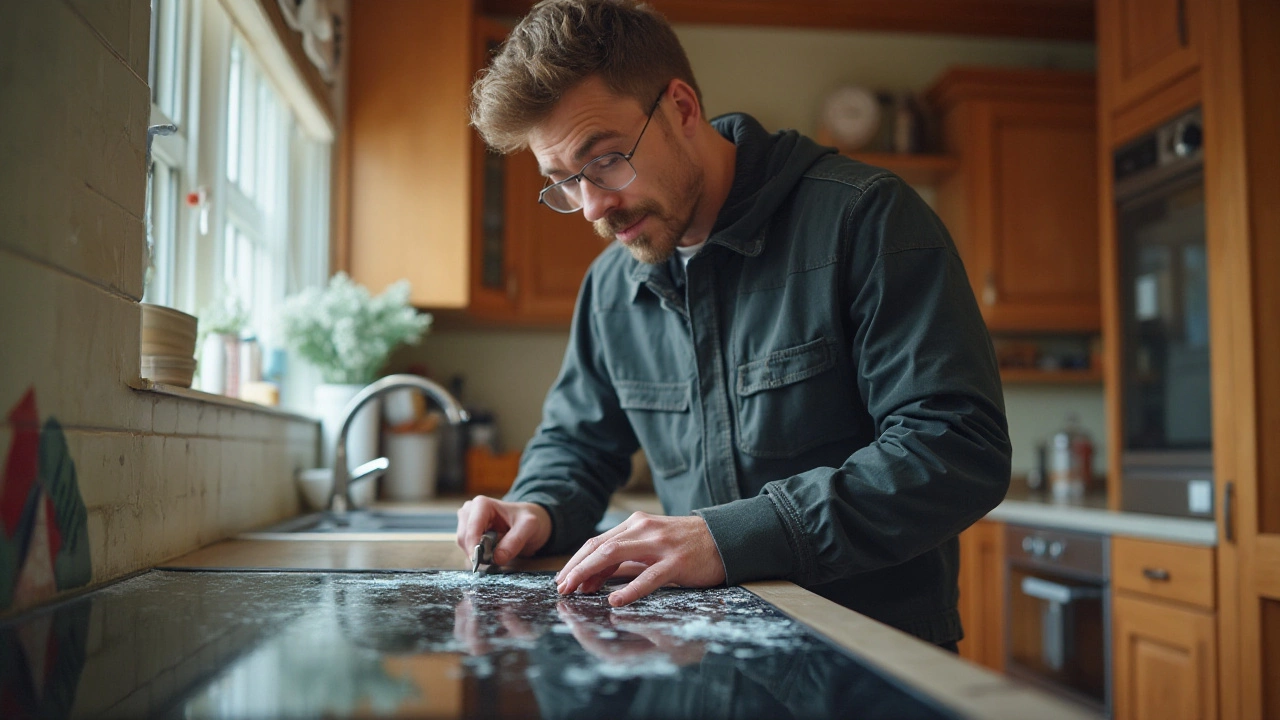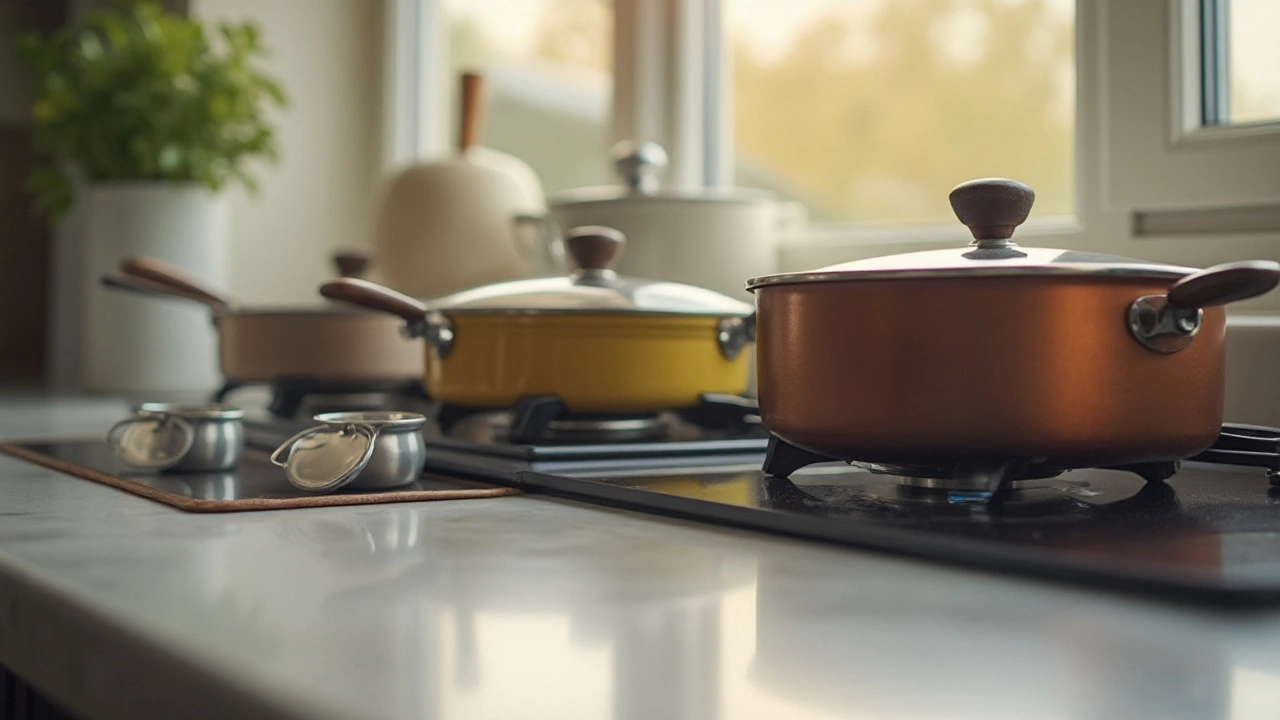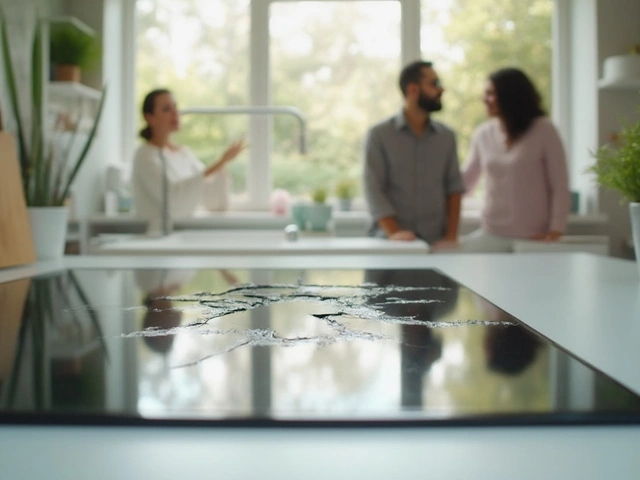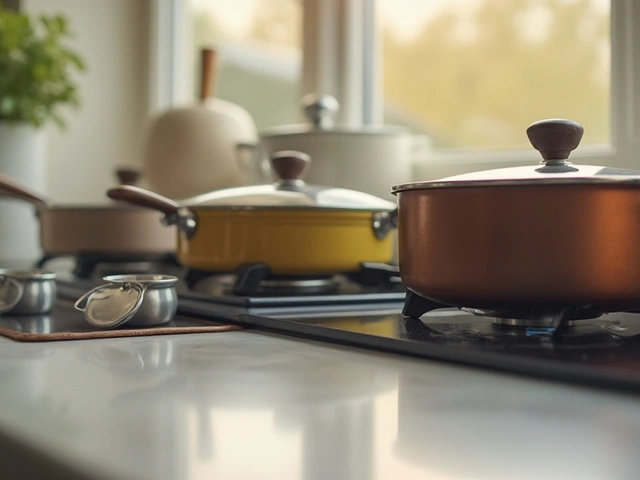Glass hobs are a stylish addition to any modern kitchen, but like any appliance, they can run into problems. Whether it's a small crack or a shattered surface, knowing how much you might spend on repair is crucial. Understanding the cost factors involved can help you make an informed decision.
Before diving into costs, it's essential to know the common issues that can arise with glass hobs. Chips, burns, and scratches can happen over time, each presenting unique challenges in repairs. Assessing the extent of the damage will often dictate whether a repair is practical or if replacement is necessary.
- Understanding Common Glass Hob Issues
- Assessing the Damage: When to Repair or Replace
- Cost Breakdown of Typical Repairs
- Hiring a Professional: What to Expect
- Maintaining Your Glass Hob to Cut Down Future Costs
Understanding Common Glass Hob Issues
When it comes to modern kitchen appliances, the glass hob stands out not only for its sleek design but also for its efficiency. However, with style and innovation comes the inevitability of wear and tear. One common issue is surface cracking. This can often be traced back to thermal stress, which happens when the hob is subjected to sudden changes in temperature. For instance, placing cold pots on a hot hob or boiling water on a chilled surface can create stress points that manifest as cracks.
Another frequent problem is scratching, which may occur from sliding cookware with rough bottoms. Though many glass hobs are designed to resist minor abrasions, over time, repeated actions with harsh materials can wear down the surface. This not only impacts the look but can also affect the efficiency of heat distribution.
Burn marks are also a concern. These stains usually occur when food spills are not immediately cleaned and get burned into the surface during cooking. Over time, they can become stubborn, making them hard to remove. While they may not affect functionality immediately, they do detract from the aesthetics and might lead to deeper damage if not addressed.
Occasionally, some users encounter issues with discoloration, which generally arises from using incorrect cleaning agents. Harsh chemicals not suited for glass surfaces can leave the hob appearing cloudy or streaked. This, while mostly cosmetic, can be frustrating for those aiming to maintain a pristine kitchen appearance.
Lastly, electronic issues, though less common, can occur. These are particularly pertinent to modern glass hobs with touch controls. Sometimes, these sensors can malfunction due to accumulated dirt or moisture around the control panel, rendering the hob less responsive or even unresponsive.
As noted by the Kitchen Appliance Experts' Association, "A stitch in time saves nine. Regular maintenance and understanding the root of common issues can significantly extend the life of your glass hob."
Understanding these common issues empowers you to take timely action, ensuring both the longevity and performance of your hob. Being proactive in addressing minor damages can prevent them from escalating into costly repairs.
Assessing the Damage: When to Repair or Replace
When your glass hob repair is in question, the first and most crucial step is to thoroughly assess the damage. It is not always clear if a repair will suffice or if a replacement is inevitable. The nature of the damage often determines the course of action. Small chips and scratches can typically be repaired. However, more severe cracks, especially those extending across the hob, introduce risks that are worth examining closely.
Small imperfections, like minor chips on the surface, might appear insignificant. Yet, if left unattended, they could worsen. In many cases, these can be filled or polished to restore the hob's smooth finish. Burns, another common blemish, may only affect the superficial layer without undermining the overall integrity. For these superficial damages, seeking a professional repair can ensure safety and aesthetics.
Conversely, when damage extends beyond mere surface imperfections, it is worth considering replacement instead of repair. Cracks that penetrate deeply or cover an extensive area compromise the hob's structural integrity. These need meticulous evaluation. The risks of using a compromised hob range from inefficient heat distribution to hazardous breakages. Safety should always be prioritized over cost-savings.
"It’s advised to replace glass hobs if the crack is larger than a few inches — the potential for injury isn’t worth the risk," says John Matthews, a seasoned appliance engineer.
The cost difference between repair and replacement can be substantial, and sometimes a repair might seem like the cost-effective choice. However, it's essential to assess the long-term reliability of a repaired glass hob. It might initially save you money, but if the problem recurs, you'll end up spending more in subsequent repairs. A new hob, while more expensive upfront, could offer a more durable and safer solution in the long run. Weighing these considerations and consulting professionals can help make the best choice.

Cost Breakdown of Typical Repairs
When your glass hob goes on the fritz, understanding what's going to impact your wallet is invaluable. Whether you're dealing with a minor scratch or a chunk missing from your cooktop, the cost to repair a glass hob can fluctuate significantly. Generally, the specific damage type and size contribute largely to the pricing. For instance, fixing surface-level scratches might set you back as little as $50 to $150. These kinds of repairs are often manageable on your own if you have the right materials, but professional touch-ups ensure a seamless finish. On the other hand, chips or cracks that compromise the functionality of the hob can command anywhere from $150 to $400, especially if a replacement part is necessary.
Substantial damage, such as deep cracks or a completely shattered hob, unfortunately means breaking out the big bucks. Replacement parts typically make up the bulk of the cost, with most glass tops priced between $200 and $600, depending on the brand and model. Don’t forget to factor in labor costs, which can range from $100 to $200. In some cases, particularly where the warranty is active, part of these expenses might be covered by the manufacturer. A tidbit worth noting: many manufacturers have specific authorized repair services to ensure the work meets their quality standards.
To give you an idea of typical repair costs, here's a simple breakdown:
| Type of Repair | Estimated Cost |
|---|---|
| Scratch Removal | $50 - $150 |
| Chip Repair | $150 - $250 |
| Crack Restoration | $250 - $400 |
| Full Replacement | $300 - $800 |
The significance of staying informed can't be overstated. Understanding the potential expenses helps you prepare financially and ensures you get fair quotes from professionals. Keep in mind, technicians certified by your hob’s manufacturer may provide slightly more expensive services, but this often comes with added peace of mind.
A report by Consumer Reports highlights, "While DIY repairs can seem cost-effective, they often miss the precision and warranty guarantees offered by certified professionals."Whether choosing DIY or professional service, ensure you get assessments from multiple sources to compare their expertise, services, and prices.
Hiring a Professional: What to Expect
When your beloved glass hob starts showing signs of wear or damage, pondering over the decision to hire a professional can feel daunting. But bringing in a professional not only ensures quality repair but can save you from potential long-term troubles. A qualified technician brings expertise and specialized tools tailored specifically for hob repair, ensuring that the job is executed efficiently. The first thing you can expect is a thorough assessment of the damage, which involves examining any cracks, checking for deeper structural issues, and evaluating any electronic malfunction. In many instances, professionals perform these assessments without charging initially, providing a free estimate before any work begins.
Once the assessment is complete, you will receive a detailed breakdown of the potential repair costs. This breakdown often includes labor charges, cost of replacement parts, and likely any additional services. It’s crucial to discuss these charges upfront to avoid any hidden costs later. In more technical repairs, especially if internal electronics or wiring are involved, the costs can seem daunting. However, that might be an insurable damage under your appliance warranty or home insurance plan, a detail that the professional can help clarify and facilitate claims for.
Now, here’s a handy tip, straight from experienced technicians – during their visits, ask for maintenance advice. Most are happy to oblige with tips on maintaining your hob, extending its lifespan, and even showing tricks to handle minor issues yourself. After the repair, professionals will test your hob to ensure it is functioning correctly. Expect a little tutorial on how to use any new parts or adjustments safely. Certified companies typically offer a short-term guarantee on their repairs, so don’t hesitate to seek clarification about warranty policies.
According to a survey by Home Appliance Technicians Association, "75% of homeowners experienced fewer repeat repairs on hobs when serviced by certified professionals".
One valuable piece of advice gathered during interviews with seasoned repair experts is to verify credentials before hiring. Ensure that the technician is accredited by recognized bodies, such as the NICEIC for electrical components or a relevant regional accreditation service. Many reputable services proudly display their credentials and customer reviews online, so a quick online check can provide peace of mind before they handle your expensive kitchen appliances. Hiring trained professionals minimizes safety risks and often means there's someone accountable if things go awry.

Maintaining Your Glass Hob to Cut Down Future Costs
Proper care and regular maintenance of your glass hob are the keys to preserving its longevity and beauty, drastically reducing the need for costly repairs. Keeping your glass hob pristine starts with cleanliness. It's crucial to clean the glass surface after every use. Not only does this prevent the buildup of stubborn stains, but it also helps avoid scratches that can occur from food particles becoming hardened over time. Use a soft cloth and cleaner specified for glass surfaces; harsh or abrasive materials can dull or damage the finish.
Another vital tip is to be mindful of the cookware you use. Ensuring the bottoms of pots and pans are smooth and clean will prevent scratching and other damage. Over time, dirt or burrs on cookware can create deep gouges in the glass, leading to more significant issues. Try to avoid sliding pots across the hob; lifting them instead is a small habit that can make a significant difference.
Regularly inspect your hob for any signs of wear or damage. Identifying and addressing minor issues early can prevent them from escalating. For example, if you notice any chips or cracks, it's wise to consult a professional as soon as possible. Although some might see it as minor, these can turn into bigger problems if left unchecked. Attention to these details can save considerable expense in future repair costs.
“Preventive maintenance is not a cost but an investment.” – Henry Ford
Keeping an eye on the hob's performance is another aspect of maintenance. Sometimes, troubleshooting smaller problems such as uneven heating or defective controls yourself can save you the hassle and expense of larger fixes. Consult your hob’s manual for troubleshooting tips tailored to its make and model. However, never attempt repairs that could potentially harm the appliance or yourself.
Essential Heating Tips
Managing the heat correctly is also crucial for your hob’s longevity. Start by always placing pots and pans at the center of the hob's heating elements. Uneven distribution of heat can strain and cause cracks. Use the correct hob settings as indicated for different types of cooking. Avoid exposing your hob to sudden changes in temperature, which can lead to thermal shocks and cracking.
For those who want to extend their hob's life even further, consider installing a protector when not in use. This simple act can shield it from accidental damage. Additionally, investing in a stove guard can help prevent spills from reaching the control areas of your hob and causing internal damage.
| Maintenance Task | Recommended Frequency |
|---|---|
| Surface Cleaning | After Every Use |
| Inspect for Damage | Monthly |
| Check Cookware for Wear | Quarterly |
Incorporating these simple practices into your routine not only keeps your kitchen looking its best but also safeguards your investment. As you nurture these habits, you're likely to enjoy a high-performing and aesthetically pleasing glass hob for years to come.




